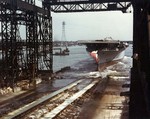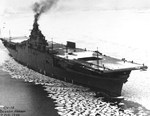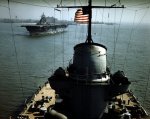Lexington (Essex-class)
| Country | United States |
| Ship Class | Essex-Class Aircraft Carrier |
| Hull Number | CV-16 |
| Builder | Bethlehem Fore River Shipyard |
| Laid Down Date | 15 Jul 1941 |
| Launch Date | 23 Sep 1942 |
| Commission Date | 17 Feb 1943 |
| Decommission Date | 8 Nov 1991 |
| Displacement | 27,100 tons standard; 36,380 tons full |
| Length | 872 feet |
| Beam | 147 feet |
| Draft | 28 feet |
| Machinery | Eight 565psi boilers, four Westinghouse geared steam turbines, four shafts |
| Bunkerage | 6,330t fuel oil; 240,000gal aviation fuel |
| Power Output | 150,000 shaft horsepower |
| Speed | 33 knots |
| Range | 20,000nm at 15 knots |
| Crew | 2,600 |
| Armament | 4x2x127mm 38 caliber guns, 4x1x127mm 38 caliber guns, 8x4x40mm 56 caliber guns, 46x20mm 78 caliber guns |
| Armor | 60-100mm belt, 40mm hangar and protective decks, 100mm bulkheads, 40mm pilot house (special treatment steel), 60mm top of steering gear |
| Aircraft | 110 |
Contributor: David Stubblebine
ww2dbaseThe second Essex-class aircraft carrier was laid down as the Cabot on 15 Jul 1941 at the Bethlehem Steel Company in Quincy, Massachusetts, United States. After nearly a year of construction, the ship was renamed Lexington in honor of the earlier carrier Lexington lost in the Battle of the Coral Sea three weeks before. The Essex-class Lexington was commissioned 17 Feb 1943 with Captain Felix B. Stump in command.
ww2dbaseAfter a shakedown cruise to Trinidad, Lexington sailed for the Pacific via the Panama Canal and Pearl Harbor. Her first combat came in late Sept 1943 with a raid on the Tarawa Atoll in the Gilbert Islands. Lexington supported the Gilberts Campaign through the fall before moving on to strike Kwajalein in the Marshalls on 4 Dec 1943. Late that same night, Lexington was struck by a torpedo that injured her steering. After retiring to Puget Sound, Washington for repairs, Lexington was back in action by Mar 1944.
ww2dbaseRear Admiral Marc Mitscher made Lexington his flagship for the Fast Carrier Task Force as they sailed in support of the Army's landing at Hollandia, New Guinea 13 Apr 1944. Lexington and the Task Force moved on to the Mariana Islands for some preliminary strikes against Saipan and Guam. The presence of the US fleet near the Marianas prompted a response from the Japanese that developed into the Battle of the Philippine Sea. Lexington's aircraft played a big part in what the fliers called The Great Marianas Turkey Shoot, the engagement that nearly neutralized Japanese naval aviation for the rest of the war.
ww2dbaseUsing Eniwetok as their new base, the Task Force and Lexington flew against Guam, Palaus, the Bonins, Yap, and Ulithi. General Douglas MacArthur was nearly ready to land his forces at Leyte and so the Navy began preliminary attacks on the Philippines. The Philippine operation also included strikes against Formosa (now Taiwan) and Okinawa. MacArthur's landings took place in late Oct 1944 and Lexington's planes flew strikes in the Battle of the Sibuyan Sea where they contributed to the sinking of the battleship Musashi. The next day, Lexington sailed north as Halsey was drawn away to pursue the decoy Northern Force. Then they pursued the retreating Japanese fleet and sank the heavy cruiser Nachi in Manila Bay on 5 Nov 1944, scoring four torpedo hits that blew the ship into three separate pieces.
ww2dbaseThat same day, a Japanese special attack aircraft (kamikaze) found Lexington and struck near her island. Lexington retired to the forward base at Ulithi for repairs where her crew heard over Radio Tokyo that the Lexington had been sunk. This was the fourth time this crew heard Japanese radio report that their ship was sunk.
ww2dbaseLexington returned to action almost straightaway, in time for more strikes in support of the Philippine operation before the fleet, including Lexington, sailed through Typhoon Cobra. Lexington and the fleet then steamed into the South China Sea for raids against shipping along the coast of French-Indochina as well as raids against Hong Kong, Hainan, and Formosa before taking one swipe at Okinawa to conclude the sortie.
ww2dbaseTheir next action was to be a part of the first carrier launched air strikes on the Japanese home islands since the Doolittle Raid three years earlier. Their targets were airfields near Tokyo in mid-Feb 1944 meant to minimize opposition to the Marines landing on Iwo Jima. Lexington planes then flew close support for the Marines on Iwo Jima before returning to strike the Japanese home islands. Lexington then sailed to Puget Sound again, this time for a complete overhaul.
ww2dbaseLexington was back in action again on 20 Jun 1945 with a passing strike against Wake Island while on her way to rejoin the fleet. Lexington took her place with sixteen other carriers and over 120 other warships to pound Japan's southern islands through Jul and into Aug 1945. As Lexington's planes approached the Japanese coast on 15 Aug 1945, they received orders to jettison their bombs and immediately return to the ship due to Japan's surrender.
ww2dbaseAfter hostilities ended, Lexington planes flew patrols over Japan, dropping supplies to prisoner of war camps on Honshu, Japan. She supported the occupation of Japan until leaving Tokyo Bay 3 Dec 1945 loaded with American servicemen bound for San Francisco. She remained on the west coast until she was decommissioned at Bremerton, Washington, 23 Apr 1947 and placed the Reserve Fleet.
ww2dbaseLexington began conversion and modernization at Puget Sound 1 Sep 1953 that included being fitted with an angled flight deck. She was recommissioned 15 Aug 1955 and rejoined the Pacific Fleet. Lexington alternated between west coast training cruises and Far East deployment cruises until 1962 when she moved to the Gulf of Mexico. Lexington was on alert throughout the Cuban Missile Crisis of Oct 1962. In late 1963, Lexington relieved USS Antietam as the principal aviation training carrier in the Gulf of Mexico. Lexington was based at Pensacola, Florida but also operated from Corpus Christi, Texas and New Orleans, Louisiana. On 17 Oct 1967, Lexington logged her 200,000th arrested carrier landing. In 1976 when USS Oriskany was decommissioned, Lexington became the last Essex-class carrier in commission. In Aug 1980, Lexington became the first aircraft carrier in US Naval history to have women serving in the crew.
ww2dbaseLexington served another eleven years, finally being decommissioned on 8 Nov 1991. When Lexington was decommissioned for the last time, she had more time in commission than any other aircraft carrier in the world, a record she still holds. At the time of her retirement, Lexington also held the world record for the carrier with the most arrested "trap" aircraft landings.
ww2dbaseIn 1992, the ship was donated as a museum ship and now operates as the "USS Lexington Museum on the Bay" in Corpus Christi, Texas. Portions of Lexington's original wooden flight deck are preserved in a small carrier deck mock-up at the National Naval Aviation Museum in Pensacola, Florida.
ww2dbaseLexington received the Presidential Unit Citation and 11 battle stars for World War II service.
ww2dbaseSources:
Dictionary of American Naval Fighting Ships
US Navy War Diaries
USS Lexington CV-16 Association
National Museum of Naval Aviation
Wikipedia
Navybuddies.com – Unofficial US Navy Site
Last Major Revision: Nov 2015
Aircraft Carrier Lexington (Essex-class) (CV-16) Interactive Map
Photographs
 |  |  |  |
Lexington (Essex-class) Operational Timeline
| 15 Jul 1941 | The keel of carrier Cabot was laid down at Quincy, Massachusetts, United States. |
| 17 Feb 1943 | Lexington (Essex-class) was commissioned into service. |
| 29 Sep 1943 | A fast carrier strike force built around carriers USS Essex, USS Yorktown, USS Lexington, USS Cowpens, USS Independence, and USS Belleau Wood, escorted by USS Nashville and other warships, departed US Territory of Hawaii for combat operations. |
| 5 Oct 1943 | Task Force 19 consisting of Essex-class carriers Essex, Lexington, and Yorktown with light carriers Cowpens, Independence, and Belleau Wood escorted by cruisers New Orleans, San Francisco, Birmingham, Nashville, Santa Fe, and Mobile and destroyers Hull, Hazelwood, Bancroft, Caldwell, Coghlan, Braine, Halford, Kidd, Bullard, Chauncey, John Rodgers, Harrison, Murray, Ringgold, Sigsbee, Schroeder, Dashiell, Conner, Burns, Boyd, and Bradford began two days of strikes against Wake Island. So intense was the bombardment that island commander Rear Admiral Sakaibara Shigemitsu was convinced it was a prelude to an invasion and he ordered the execution of all 98 remaining POWs that had been there since 23 Dec 1941, many of whom had been civilian contractors at the time of their capture. |
| 19 Nov 1943 | USS Nicholas screened carriers USS Yorktown, USS Lexington (both Essex-class), and USS Cowpens as they launched air strikes against Japanese positions on Makin, Mili, and Jaluit Atolls over 6 consecutive days. |
| 4 Dec 1943 | USS Portland and USS New Orleans (New Orleans-class), among other ships, screened carrier Lexington (Essex-class) in strikes against Kwajalein Atoll, Marshall Islands. Lexington received a torpedo hit that crippled her steering. New Orleans escorted Lexington to Pearl Harbor. |
| 22 Dec 1943 | USS Lexington (Essex-class) arrived at Puget Sound Naval Shipyard for repairs of torpedo damage. |
| 20 Feb 1944 | USS Lexington (Essex-class) departed Puget Sound Naval Shipyard after repairs. |
| 12 Oct 1944 | Carrier aircraft from USS Lexington attacked Shoka Airfield in Shoka (now Changhua), Taiwan. |
| 13 Oct 1944 | Carrier aircraft from USS Lexington attacked the rail marshaling yard at Shinei District (now Xinying District), Tainan, Taiwan. |
| 25 Oct 1944 | Off northeastern Luzon, Philippines, aircraft from US Navy Task Force 38 attacked the Japanese carrier force consisted of fleet carrier Zuikaku and light carriers Zuiho, Chitose, and Chiyoda in the Battle off Cape Engaño. The Japanese force was escorted by two battleship-carrier hybrids (Hyuga and Ise; aircraft-less on this date), three light cruisers (Oyodo, Tama, and Isuzu), and nine destroyers at about 0830 hours, 26 minutes after those planes were detected by Zuikaku's radar. The overwhelmingly larger American force, under Admiral William Halsey, centered around fleet carriers USS Lexington, USS Intrepid, USS Essex, USS Franklin, USS Enterprise, further bolstered by a great many light carriers, battleships, cruisers, and destroyers. Zuikaku was damaged by skilled damage control teams extinguished the fires and corrected the listing by 0850 hours. Chitose was fatally damaged by the first attack wave, sinking at 0937 hours. At 0953 hours, a second attack wave struck, fatally damaging Chiyoda, leaving her dead in the water to be sunk by American destroyers later at 1655 hours. The second wave also damaged Zuiho's flight deck, the last functional flight deck of Vice Admiral Jisaburo Ozawa's force; Japanese combat air patrol planes in the air would need to ditch when they ran out of fuel. At 1032 hours, Ozawa transferred his flag from the damaged Zuikaku to Oyodo. At 1308, the Japanese sighted an incoming third wave of American aircraft. Six torpedoes struck Zuikaku, causing massive flooding and several fires in the hangar; the commanding officer addressed the surviving crew, ordered the lowering of the ensign, and gave the abandon ship order at 1358 hours; Zuikaku sank by the stern at 1414 hours. Zuiho suffered two torpedo, two bomb hits, and a great many near-misses during the third attack wave, and she was dead in the water at 1445 hours. At 1455 hours, a fourth wave struck, sealing the doom of Zuiho with ten near-misses, leading to Zuiho's commanding officer giving the abandon ship order; she sank at 1526 hours. |
| 5 Nov 1944 | The Aircraft Carrier USS Lexington (CV-16) was damaged by a kamikaze special attack. |
| 18 Dec 1944 | Many ships from the United States Third Fleet, Task Force 38 sailed into Typhoon Cobra in the Philippine Sea. Three destroyers and 790 men were lost. |
| 27 Mar 1945 | USS Lexington (Essex-class) arrived at Puget Sound Naval Shipyard for an overhaul. |
| 29 May 1945 | USS Lexington (Essex-class) departed Puget Sound Naval Shipyard after overhaul. |
| 3 Dec 1945 | USS Lexington departed Tokyo Bay, Japan for San Francisco, California, United States with US servicemen on board. |
| 23 Apr 1947 | USS Lexington was decommissioned at Puget Sound Naval Shipyard, Bremerton, Washington, United States. |
| 1 Sep 1953 | The conversion and modernization work on carrier Lexington began at Puget Sound Naval Shipyard, Bremerton, Washington, United States. |
| 8 Nov 1991 | USS Lexington was decommissioned from service for the last time, the last of the Essex-class to be taken out of service. Lexington had more time in commission than any other aircraft carrier in the world, a record she still holds. At the time of her retirement, Lexington also held the world record for the carrier with the most arrested "trap" aircraft landings at almost 500,000. |
Please consider supporting us on Patreon. Even $1 per month will go a long way! Thank you. Please help us spread the word: Stay updated with WW2DB: |

» Mitscher, Marc
Event(s) Participated:
» New Guinea-Papua Campaign, Phase 3
» Gilbert Islands Campaign
» Marshall Islands Campaign
» Mariana Islands Campaign
» Palau Islands and Ulithi Islands Campaigns
» Philippines Campaign, Phase 1, the Leyte Campaign
» Philippines Campaign, Phase 2
» Typhoon Cobra
» Raid into the South China Sea
» Battle of Iwo Jima
» Okinawa Campaign
» Preparations for Invasion of Japan
» Japan's Surrender
Document(s):
» US Aircraft Carrier Functions
» US Aircraft Carrier Operational Status By Month
» US Carrier Time Operational
 |
- » 1,181 biographies
- » 337 events
- » 45,111 timeline entries
- » 1,247 ships
- » 350 aircraft models
- » 207 vehicle models
- » 376 weapon models
- » 123 historical documents
- » 261 facilities
- » 470 book reviews
- » 28,470 photos
- » 365 maps
George Patton, 31 May 1944
Please consider supporting us on Patreon. Even $1 a month will go a long way. Thank you!
Or, please support us by purchasing some WW2DB merchandise at TeeSpring, Thank you!